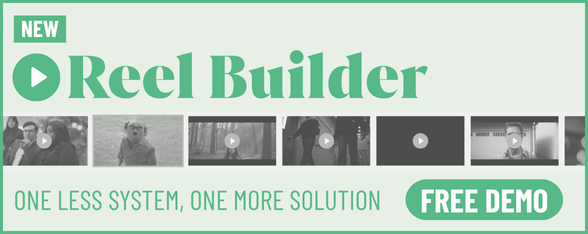
What Does Good Social Content Look like to You?

Jake Thompson is creative director at Spin. With a decade of social experience in the industry, Jake leads the creative team’s accounts.
He has helped build some of the most talked-about campaigns in the industry and has won numerous awards (including a ‘30 Under 30’).
Spin, an independent, 360 social agency with clients across almost every continent, has more than 75 full-time employees primarily based in London, and continues to experience impressive growth year on year.
LBB> What’s the most significant development or trend shaping the social space right now?
Jake> Social-as-search. It’s driving the obsession with branded UGC that’s product-forward but feels like it belongs in your feed.
Why does this content work? Because it slots naturally into moments when audiences are actively looking for something, consciously or subconsciously. Good UGC balances functionality, spot-on audience insight, and timeliness by tapping into trending formats and real (read: not focussed grouped, idealised) occasions.
We've noticed a dramatic shift in paid briefs too, as brands chase this style for its undeniable performance.
But it's also creating a race to the bottom, saturating feeds with similar content. Smart brands will soon pivot towards distinctive IP and original franchises to regain differentiation and a first-mover advantage. That’s where the real fun is.
LBB> Every platform functions so differently – and the way they function evolves over time and there’s a lot of fun to be had on social, from shoppable livestreams to AI filters – so where are you finding the most satisfying or exciting creative opportunities right now?
Jake> Branded entertainment and distinctive content franchises are not just creatively fulfilling, they deliver on KPIs too. Our recent ‘Nonna Knows Best’ campaign for Napolina is a prime example.
We created a larger-than-life Nonna who swoops in to correct cooking mishaps, blending humour and authentic Italian heritage. The campaign demonstrated perfectly how brands can be playful, distinctive, and build emotional connection – whilst smashing the objectives.
Sure, platform features like shoppable livestreams and AI filters are exciting, but not every feature suits every brand. The trick is knowing your audience deeply, understanding their behaviours, and showing up thoughtfully, rather than frantically hopping on every trend.
Focus on doing something really f*cking well.
LBB> Social media is a space for brands to be a bit more human – but how do you walk the line between personable and twee?
Jake> It all starts with a tone of voice document, brief, example-heavy, and void of fluff.
Buzzwords like 'fun' or 'authentic' won’t cut it because their opposites are absurd, no one aims to be 'sad' or 'inauthentic'.
Effective TOV should clearly define how a brand speaks when it’s proud, frustrated, or excited even, creating a nuanced persona rather than a flat caricature. Imperfection is central to social.
So find your imperfections, lean into them, and never, ever break character.
A brand that got this balance right? Big Sexy Pizza. We leaned into Lewis Capaldi’s unfiltered, self-aware humour, building a social presence that was weird, funny, and totally in character. It worked because it never tried to sound like anyone else.
LBB> What does ‘craft’ mean to you in a social context?
Jake> Craft isn't about expensive production, it's about thoughtful, intentional creation. My frustration isn’t poorly-produced content, it's content that’s unclear in concept or relevance.
Craft means making sure your content fits seamlessly into conversations rather than interrupting them with something so devoid of value it’s an irritant.
It's copy that hooks you, the perfect trending sound, the right pacing, all viewed through the lens of your audience. When content feels inevitable, like it simply *had* to exist, that’s craft.
We see this in action with Google Cloud, one of our B2B clients that could’ve leaned dry, but we rebuilt the creative from the ground up to be platform-native and truly audience-led. The result? +428% engagement. Relevance + execution.
LBB> Organic, paid, influencers, social search - how do you approach figuring out the best way to reach audiences?
Jake> Find where your audience already is, what are they genuinely interested in today, right now? Can your brand add meaningfully, or would you just be interrupting?
I'm an advocate for 360 social, breaking silos and building an approach that connects every part of the user journey. The beauty of social is its agility, we can gently nudge audiences through the funnel in ways other channels just can't.
Trust your creative and strategic teams to connect these dots.
LBB> Social media can be brutal – on a personal level how do you deal with that aspect of the role and helping your teams on the front line?
Jake> There's a healthy detachment needed, coupled with an empathetic curiosity, always asking "why" rather than spiralling into introspection. Social is active, feedback is immediate and sometimes harsh.
But resilience comes from understanding you learn, improve, and move forward. Passion and a touch of ego help, but your worth can't hinge on likes or shares. Tomorrow, we create again.
LBB> Social media has been accused of driving polarisation and spreading misinformation, while others call it the marketplace of ideas. Whether or not that’s the whole truth, it is certainly shaping discourse and is one of the key venues for culture war-ish behaviour. What’s your take on the role of social media in society and what responsibilities do brands and individuals working in social have?
Jake> I think both statements are true. It is polarising. It does help rapidly spread misinformation. But it’s also a marketplace of ideas. It’s democratised access to information. It gives voiceless people a voice.
Yes, it’s flawed. But switching it off wouldn’t reduce polarisation, that’s societal, not technological. Social acts as a mirror reflecting deeper issues. For brands I’d say this: try and resist falling into indifference, stand for something meaningful, show your humanity. If for no other reason than it’s the right thing to do.
To those of us working in this industry: don’t be lazy. Don’t feed the beast with more hate, more division. It might be engagement bait, but it won’t save your soul.
LBB> What are the biggest missteps you see brands making most regularly on social media?
Jake> Posting.
LBB> Inevitable AI question! How are you applying AI in your day-to-day role and what have been your key insights/observations about the best way to approach it in the campaigns you’ve worked on (feel free to share examples)?
Jake> AI gives me a dozen smarter versions of myself at the touch of a button, not to replace my thinking, but to speed it up, sharpen it, stress-test it.
I’ve trained GPTs to mirror how I think, taught it what I value creatively, even what I can’t stand. I use it to detangle messy thoughts, pressure-test a concept, scamp up visuals (because I still can’t draw), and add that final bit of polish when the idea’s nearly there and I’m running out of time.
Take our recent campaign for Five Guys, we turned around a shoot with kids, on location, within days of receiving the brief. AI helped us get there faster so we could focus on crafting the output.
This is possible because myself, and my team, have put in the work. Because the real trick is to be specific. Teach it your taste. The better your direction, the better the output. It’s not a shortcut, it’s a co-pilot. And if you use it right, it doesn’t dilute the work, it enhances it.
LBB> Thinking longer term, where do you see the biggest risks and opportunities when it comes to AI in social?
Jake> The biggest risk with AI in social is that it fuels more of the same beige, soulless content we’re already drowning in. If brands treat it as a way to fill content gaps or hit quotas faster, feeds will become even more forgettable.
But the opportunity of AI is huge. It gives more people access to better tools, to visualise, iterate, and polish ideas that might’ve otherwise stayed pretty average. If used well, it can raise the creative bar. Like every great tool before it, it’s about how you use it. More creative direction, less churn and burn. That’s the win.
LBB> When you’re not working, what social platforms and content do you personally enjoy engaging with and why?
Jake> Social, for me, is mostly escapism. I gravitate towards TikTok and YouTube to unwind, to laugh, to learn something random, to watch someone pickle an egg for the fourth time. I want entertainment. I want to feel like I’ve watched an episode of something, even if it’s just 25 videos in a row about how they built the Hoover Dam. And if I happen to pick up a skincare tip or a recipe along the way? Bonus.
I’m also using social as a search function more and more. If I’m buying a new pair of shorts or looking for a dinner spot, I’m on TikTok first. It’s instinctual now. The algorithm just knows what I need, even when I don’t. Sorry Google x
LBB> What creators, influencers and social communities do you really love?
Jake> For the most part, I’m all about creators who come across like real people, a bit messy, a bit unfiltered, but magnetic. Ones who make content that genuinely adds something to my day. Big or small. Below’s a few of my (current) favourites…
Mads - Nobody makes food content like Mads. She’s funny, chaotic, comforting, and often creates weirdly beautiful food. You can tell she’s not trying to be anyone but herself, and that’s exactly what makes her so watchable. She’s got the kind of energy where you feel like you’d actually be good mates in real life. I’ve 100% bought snacks, dips, tinned fish and takeaways because of her.
SortedFood - I’ve been watching these guys for over a decade and they still keep me entertained. It’s just a bunch of mates cooking, taking the p*ss, and somehow building one of the best food communities on social. They’ve nailed that balance of high-quality content and pure, unadulterated, fun. Do I cook the recipes? No. Do I share their videos with my mates? Absolutely.
Alfie Deyes - A bit of a nostalgic follow, I won’t lie. I’ve grown up with Alfie in the background and there’s something really grounding about his content now. It’s thoughtful, honest, and still very much him. I admire how he’s evolved, and stayed human through it all. It’s rare, and he’s honestly the closest thing I have to a role model. Big up the brit crew.
Robert Irwin - No comment.
LBB> What advice would you give to people who are looking to get into social, whether as creatives, strategists or producers?
Jake> Really ask yourself: are you actually obsessed with social? Not in a screen-time way, I mean do you genuinely enjoy the space? Do you see its potential? Do you understand the language of it, the culture, the speed?
One of the biggest red flags in an interview is someone who talks endlessly about marketing principles, but clearly isn’t living in the world they want to work in.
Theory is fine, helpful even, but if you’re not immersed in that world, how can you expect to make anything that truly belongs there?
So be honest with yourself. Our industry doesn’t need any more people pretending to get it. If you do get it, show us. Create something. Have an idea. Make it make sense. One of my favourite questions to ask is: “What does good social content look like to you?” There’s no single right answer, but there are plenty of wrong ones.













